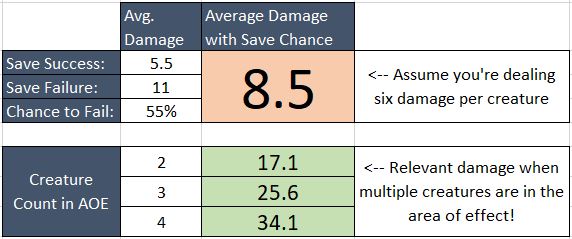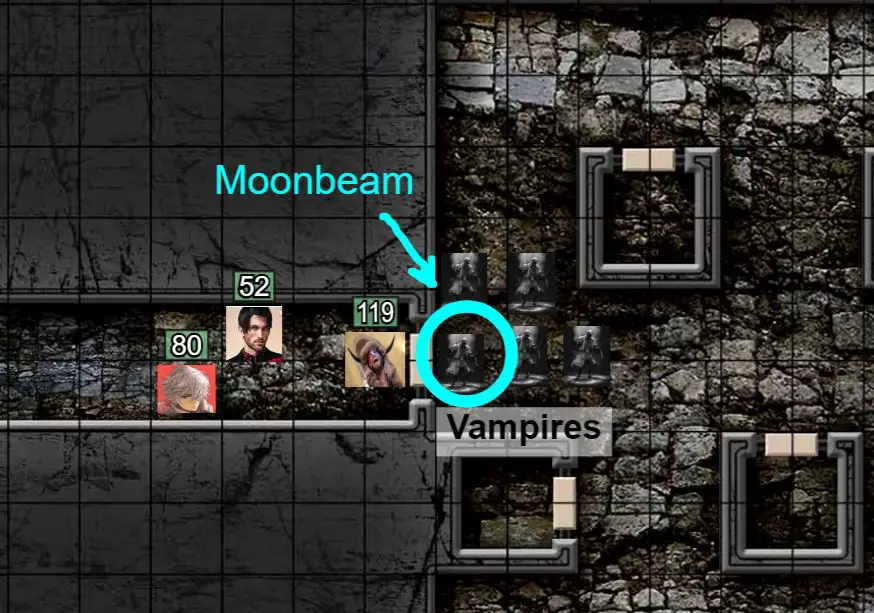Featured D&D 5e Moonbeam image credit to Wizards of the Coast’s book Mythic Odysseys of Theros..
Disclaimer: This article contains affiliate links that add gold to our coffers.
Moonbeam is a second-level that all Druids can cast. Several other classes’ subclasses can cast it, too. It’s a spell that used to be cool, but now it’s a pet peeve of mine. I feel compelled to tell the world why I’m annoyed by Moonbeam!
I’ll describe why it’s my pet peeve, how it can be used effectively, and discuss some of the other considerations for old MB. I’ll discuss AOE (area of effect), DPR (damage per round), and more.
Why Moonbeam Tilts Me
The spell itself is fine, but eight years of playing this game have shown me that players overvalue this spell. Players cast it in the worst situations where they do less damage than if they used a cantrip or other option, and at its worst, it has harmed the player’s allies.
I saw Moonbeam used by Druids over the years (and occasionally Ancients Paladins). Several subclasses have received Moonbeam as a subclass spell in recent publications (Twilight Cleric, Watchers Paladin). As Moonbeam spreads, my self-imposed duty to pump the brakes on Moonbeam grows in urgency.
Moonbeam wouldn’t be on my naughty list if it weren’t for this trend I’ve observed! Players seem to love the concept of Moonbeam so much that it causes tactical tunnel vision.
Since it uses a Constitution saving throw, monsters likely fail the saving throw 50-60% of the time. That’s not bad, but I’ve played too much Pokemon to rely on that kind of success rate. Monsters who succeed will avoid half of the damage, resulting in a pitiful DPR for the Moonbeam. The average damage roll for 2d10 is 11, and that’s halved to 5. Yikes. The area of effect is small, too. You’re not likely to get a bulk deal with Moonbeam.
Radiant damage is one of the best damage types in the game, so that’s one benefit to the spell. It’s especially effective against creatures like vampires who suffer side effects to radiant damage.
Furthermore, players are often confused about Moonbeam not dealing damage when it first appears. Even after multiple instances of explaining it, they continue to be disappointed when they don’t get to deal its damage twice in the first round.

Moonbeam in Chokepoints
This is one of the few times casting Moonbeam seems appropriate, though it has competition and opportunity costs with other Druid spells that I’ll list. Moonbeam works well in a chokepoint, but it’s not the best clog spell.
In my experience, most DMs will stack enemies up at a bottleneck without using the rules for moving through their allies temporarily. It’s important to halt enemy movement if your DM knows enemies can move through one another’s spaces as difficult terrain to take turns hitting whoever is blocking the way.
Moonbeam is an adequate clog spell for chokepoints. If you ever have to use your action to move the Moonbeam, you’re probably getting negative value out of your spell slot from a DPR perspective.

Chokepoint Opportunity Cost Spells
These spells are similarly useful in chokepoints to block, hinder, or harm enemies trying to move through. Some are better for groups of enemies while others are better for solo enemies. Buffing and healing allies can also be important.
Clogging Druid Spells
- Dust Devil: In the right circumstances with air and dirt, Dust Devil functions as a pusher, visibility blocker, and damager. This combines the benefits of Fog Cloud, Thunderwave, and Moonbeam, though to a lesser degree (less damage, smaller area, etc.). It costs a bonus action to move it.
- Flaming Sphere: This is often superior to Moonbeam because it uses a bonus action, but Moonbeam may be better in chokepoints where you may not need to move the persistent effect. Moonbeam’s radiant damage is also better.
- Fog Cloud: Block vision completely to make ranged attacks risky through the fog and tactical coordination difficult.
- Spike Growth: This is the spell of choice when your DM is moving enemies through one another to take turns striking your pointman. This will force them to slow down as its difficult terrain, and the damage will make them think twice about moving through the area.
- Summon Beast: When you lack a pointman, a summoned beast may be best for plugging a chokepoint. This is especially effective for making your getaway while slowing enemies down to deal with your beast.
Other Chokepoint Support Druid Spells
- Entangle: No concentration required to stop enemies in their tracks. The problem is that a chokepoint will already limit enemy movement, lessening Entangles value. As I mentioned, Entangle’s movement hindrance will be more important if your DM knows enemies can move through their allies.
- Healing Spirit: Cast as a bonus action and move it thereafter as a bonus action. Plant it on your pointman at the chokepoint to heal them each round. Remember the errata for this spell that gives it a cap on how frequently it can heal a given creature.
- Heat Metal: Perfect against a single enemy with metal armor or a single metal weapon. You can give them disadvantage on attacks while damaging them for the duration with no saving throw and the low cost of your bonus action each round.
Moonbeam in Open Areas
Many Druid players have the wit to choose spells like Spike Growth when they’re dealing with open wilderness battlefields. Spike Growth is far superior to Moonbeam in these situations. When an enemy is free to move around and select their positioning, Moonbeam is terrible.
If you’re attempting to solo your enemies as a Druid, you might think Moonbeam is the way to go. You’ll be right occasionally, but only if you understand its limits. You need to know how fast your enemies can move and how you can stay out of harm’s reach.
Druids of level eight and above become beasts with the ability to fly. These flying beasts move swiftly, allowing a Druid to tail fleeing enemies while moving Moonbeam 60 feet as an action. Your avian form needs to have a flying speed fast enough to keep enemies within your line of sight until you vaporize them. This combination crumbles if your enemies can move 35 feet per round because they can dash to outrun your Moonbeam each turn. They’ll escape, but you’ll be safe.
The question still remains whether you have better options than Moonbeam for these chases, and you usually do.
Moonbeam and Shapechangers
A shapechanger is a secondary classification of certain monsters. Werewolves are humanoids and shapechangers, for example. Shapechangers have disadvantage saving against Moonbeam. Furthermore, shapechangers revert to their original/true form when they fail against Moonbeam’s saving throw.
This is obviously handy against shapechangers, but I’ve found that DMs and players get confused here. Players often assume or hope a Polymorph spell will end when the transformed creature fails its Moonbeam saving throw. By the rules, Moonbeam only has this effect on creatures who are classified in their statblock as shapechangers.
You can house-rule otherwise, of course. If it makes sense to your group, allow Moonbeam to be especially effective against any creature that is not in its original form. Ask your DM how they’ll rule this. DMs, tell your players how you’ll rule this when they get Moonbeam.
Moonbeam’s Dim Light
The dim light detail has never mattered in any D&D game I’ve played in. The only scenario I can imagine it mattering is this; if a creature in the Moonbeam has disadvantage on Perception checks due to the dim light, you and your allies will have an easier time using actions to Hide.
That’s about it, but it’s debatable because I imagine DMs would start visualizing the scenario and ruling that the area outside of the Moonbeam isn’t dim light and thus the creature sees your party without issue.
Conclusion
Moonbeam deals mediocre damage and gets deployed in situations that don’t make tactical sense Its other effects regarding shapechangers and dim lighting are not widely understood by players, so they’re often misapplied and disappointing. It’s fine that its damage is delayed until a creature starts its turn in the area, but players often forget this and don’t like it.
This article isn’t a hate letter to Moonbeam, but a plea to players to make sure they understand how the spell functions and where it shines (pun intended). I hope I was helpful to that end.
What do you think? Has Moonbeam ever bothered you? Tell me if you think I’m a grumpy curmudgeon who should leave Moonbeam alone, haha.
Thanks for reading! Check out my guides to spells I enjoy far more than Moonbeam:





I’m with you on this. Early on, while learning to play, spells like moonbeam or even witch bolt that did repeated damage were really tempting. But after a few encounters using them, it didn’t take long to realize that whatever situation I was using those spells for, could be handled much more effectively in numerous different ways.
For the most part, any spell or mechanic that locks a character into a bonus action or action on subsequent terms is going to severely limit the potential of that character.
And for my spell slots, spike growth is probably top 5 overall spell in the entire game. Especially in any situation where you might be using moonbeam to block off areas or even deal damage.
Every spell probably has its moment to shine.. and a moonbeam blasted on a baseball game in Twilight is probably the right choice. But I’d usually steer clear.
I’m with you completely, Ian. You understand me!
Moonbeam + Thornwhip=meat grinder
At low levels I like Moonbeam and one advantage is being able to push enemies into it (they take damage on a turn they enter the effect). Very good versus undead (Radiant damage) and at narrow dungeon-like chokepoints. Can be used to prevent enemy rotation through the front line, or at least to make it painful. But it’s situational and one I pick when l know it is likely to be helpful. It’s not a standard adventuring option for me. CON saves make this good versus low CR enemies but usually not so useful otherwise. I think that it adds flavour for my moon druid and role play that element with both some veneration (thank you o Mother!) and delight.
Great notes! It sounds like you use the Moonbeam spell effectively.